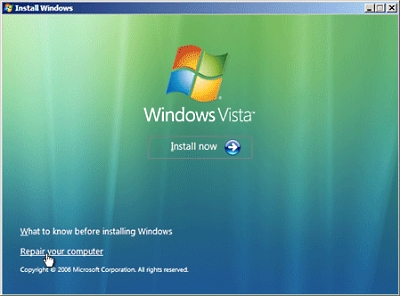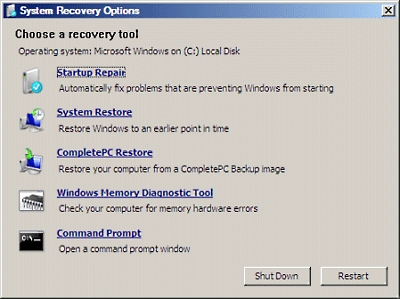When a computer won't boot from its hard drive, it's been standard practice to boot it from a floppy disk which contains files that let you start the computer in order to troubleshoot and make repairs. This floppy disk was called a boot disk or a startup disk. The ability to use a boot disk was a security risk, because anyone with a boot disk could bypass login, start the computer, and access any files.
Hard disks formatted with NTFS have built-in security features that prevent using a boot disk to access their files. The boot disk for Windows Vista is actually the Windows installation disc. It contains the files necessary to start Windows. If Vista won't start, you can use the installation disc as a boot disc.
The Vista installation disc contains a utility called Startup Repair. When you run Startup Repair, it automatically scans your computer for the problem and and tries to fix it. Startup Repair will automatically fix certain problems that prevent Windows from starting, such as missing or damaged system files.
To use Startup Repair on the Vista installation disc your computer's BIOS must be configured with the disc drive as the first boot device. If the disc drive is not the first boot device, you'll need to change your computer's BIOS settings. This is accomplished by pressing a specific key (e.g. [F1]) at the proper moment while the computer tries to start in order to access the BIOS configuration screen. Then follow the instructions on the BIOS configuration screen.

Assuming that the computer is configured to boot from the disc drive, restart the computer with the installation disc inserted in the drive. When the disc starts, choose your language settings, then click Next, then Click Repair your computer. Select the operating system you want to repair, then click Next. The System Recovery Options menu will appear.

On the System Recovery Options menu, click Startup Repair. Startup Repair might prompt you to make choices as it tries to fix the problem, and if necessary, it might restart your computer as it makes repairs.
There are some problems that Startup Repair cannot fix. It cannot fix hardware failures, such as a failing hard disk or a defective memory module. It cannot remove a virus. It cannot recover personal files, such as photos or documents that have been corrupted by a virus or by the problem that caused the system failure.
Learn more at amazon.comMore Windows Troubleshooting Articles:
• Video - Dell Laptop CPU Replacement Tutorial
• System Restore: The Big Undo
• How to Diagnose Windows Blue Screen of Death (BSOD)
• Undoing a Windows Update
• How to Fix Sqmapi.dll Error
• How to Fix logoncli.dll Error
• Fix Windows 7 Boot Errors
• How to Fix propsys.dll Error
• Wireless Router Problems and Solutions
• Windows XP's Built-in Help and Support Center


